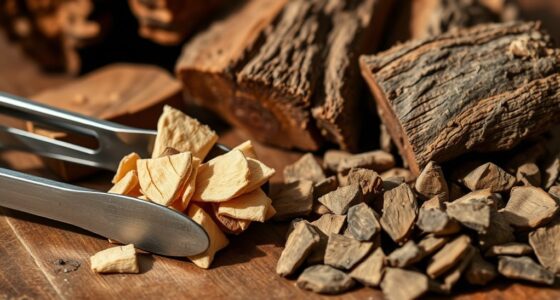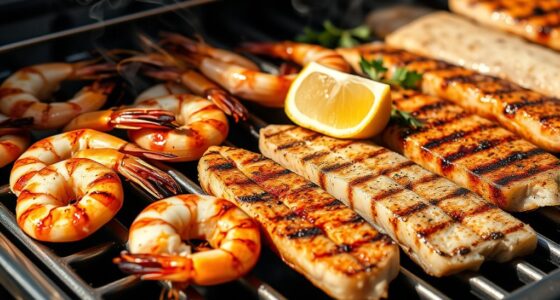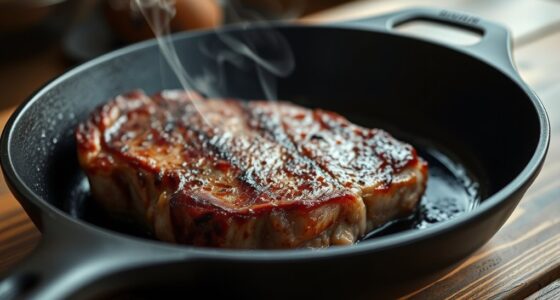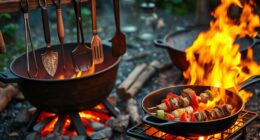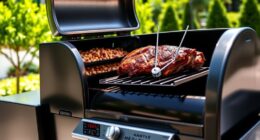To control moisture in sauces and cheeses, start by choosing high-quality, well-drained ingredients and avoid watery produce. Use heavy-bottomed pots and utensils that promote even heat and moisture evaporation. Adjust your heat to prevent excess water from boiling over or lingering. Drain or dry ingredients before cooking, and stir frequently to prevent sticking and moisture buildup. If you keep these tips in mind, you’ll master moisture balance—continue along to discover even more effective techniques.
Key Takeaways
- Do choose low-moisture cheeses like Parmesan or aged cheddar to prevent excess liquid in sauces.
- Don’t add wet ingredients like fresh tomatoes or watery vegetables without draining or drying first.
- Do use heavy-bottomed pots and wide utensils to promote even heat and moisture evaporation.
- Don’t overcook sauces or cheeses, which can cause excess water release and watery textures.
- Do incorporate straining or draining steps to remove excess moisture during preparation.
Adjust Your Cooking Techniques for Perfect Moisture Levels
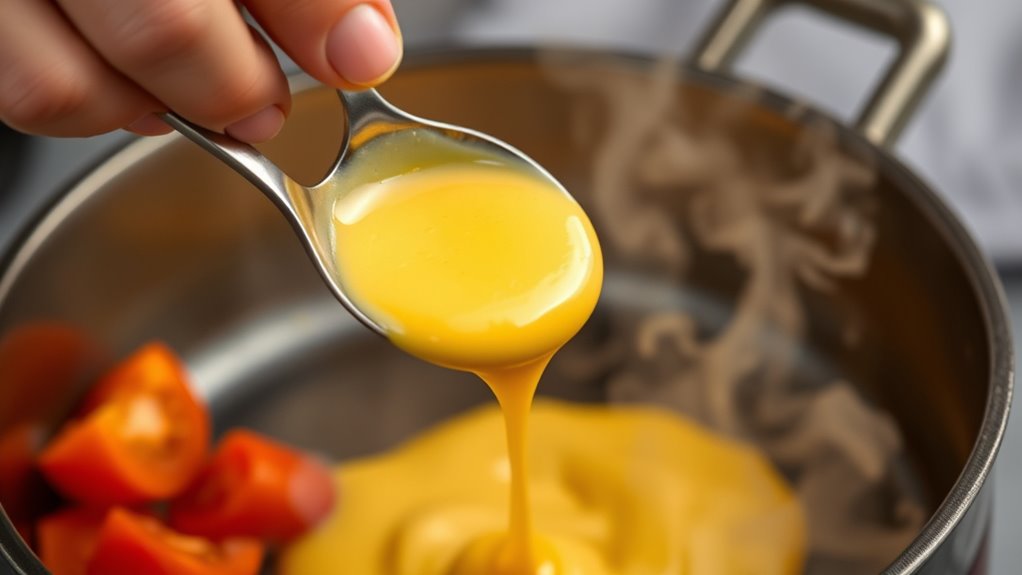
To achieve the perfect moisture levels in your sauce and cheese, you need to adjust your cooking techniques accordingly. Start with ingredient selection—choose fresh, high-quality ingredients that naturally contain the right amount of moisture. For example, selecting ripe tomatoes ensures a balanced water content, reducing the risk of excess liquid. Equally important is utensil choice; opt for heavy-bottomed pots and pans that distribute heat evenly, preventing hotspots that can cause uneven moisture evaporation. Use utensils with wide surfaces to allow excess moisture to escape during simmering or melting. Stir frequently to prevent sticking and moisture buildup. Additionally, understanding the moisture content of your ingredients can help you better control the final texture of your dish. By carefully choosing your ingredients and utensils, you gain better control over moisture levels, helping you achieve a sauce and cheese that are perfectly moist without becoming watery.
Use the Right Ingredients and Tools to Prevent Excess Water
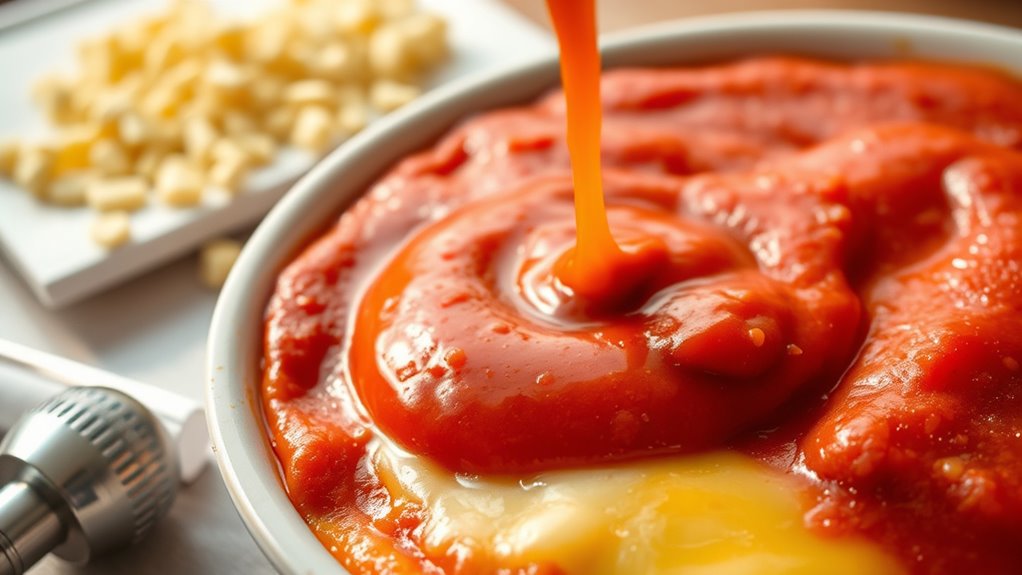
Choosing the right ingredients and tools plays a key role in preventing excess water in your sauce and cheese. Proper ingredient selection guarantees you avoid too much moisture from watery vegetables or low-quality cheeses, which can dilute your dish. Using the correct kitchen utensils helps you control moisture more effectively. For example, a fine-mesh strainer can drain excess water from ingredients, while a heavy-bottomed saucepan promotes even heat distribution and reduces moisture buildup. Additionally, selecting cheeses with lower moisture content and opting for fresh, well-drained produce can make a big difference. Changing Gears on a Gravel Bike can help you manage the cooking process more smoothly when adjusting heat levels. By choosing the right ingredients and using appropriate kitchen utensils, you can maintain ideal moisture levels and achieve a richer, more flavorful sauce and cheese.
Frequently Asked Questions
Can I Use Cornstarch to Thicken My Sauce Without Affecting Moisture?
Yes, you can use cornstarch thickening to improve your sauce without substantially affecting moisture retention. When you add cornstarch, it creates a smooth, glossy texture while helping to thicken the sauce efficiently. Just mix a small amount with cold water first to avoid lumps. This method ensures you maintain moisture, preventing your sauce from becoming too dry or overly thick, keeping the perfect balance for your dish.
How Does Resting Cheese After Shredding Impact Moisture Retention?
Resting cheese after shredding is like giving it a secret superpower for moisture retention! When you let it sit, the cheese’s texture transforms—becoming smoother and creamier—making it better at holding onto moisture. This quick pause prevents it from becoming dry or crumbly when melted. So, take a moment, let the cheese rest, and enjoy irresistibly moist, perfectly textured cheese that elevates your dish to legendary status!
Are There Specific Cookware Types That Help Control Moisture Better?
You should choose cookware like cast iron or non-stick pans to better control moisture when making sauces or melting cheese. Cast iron distributes heat evenly, helping prevent excess moisture loss, while non-stick pans reduce sticking and allow for gentler cooking. These types of cookware help maintain the right moisture levels, so your sauce stays rich and your cheese melts smoothly without becoming watery or dry.
What’s the Best Way to Prevent Cheese From Becoming Too Watery During Melting?
To prevent cheese from becoming too watery during melting, start with the right cheese selection—opt for low-moisture varieties like mozzarella or cheddar. Use proper heating by melting cheese slowly over low heat, stirring frequently to distribute heat evenly. Avoid high temperatures, which cause excess moisture. This way, you control moisture and guarantee smooth, creamy melting without watery cheese ruining your dish.
Can Pre-Salting Ingredients Reduce Excess Moisture in Sauces?
Pre-salting ingredients can help with moisture reduction in sauces. By salting ingredients ahead of time, you draw out excess water through osmosis, which reduces overall moisture content. This technique allows you to control consistency better and prevents sauces from becoming too watery. Just be careful not to over-salt; balance is key. Pre-salting is an effective way to tighten up your sauce’s texture and improve its stability during cooking.
Conclusion
To keep your sauce and cheese perfectly moist, always adjust your cooking techniques and choose the right ingredients and tools. Did you know that over 60% of home cooks struggle with excess moisture? By following these simple tips, you’ll avoid watery dishes and achieve that ideal texture every time. Remember, controlling moisture isn’t just about taste — it’s about elevating the quality of your dishes and impressing everyone at your table.


